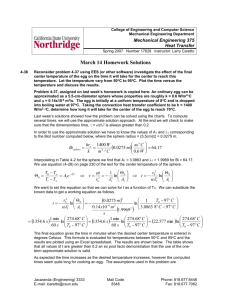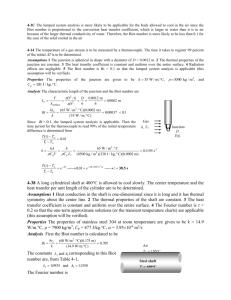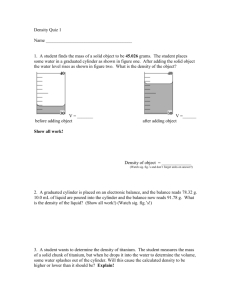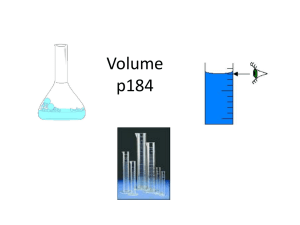Unit 6: March 12
advertisement
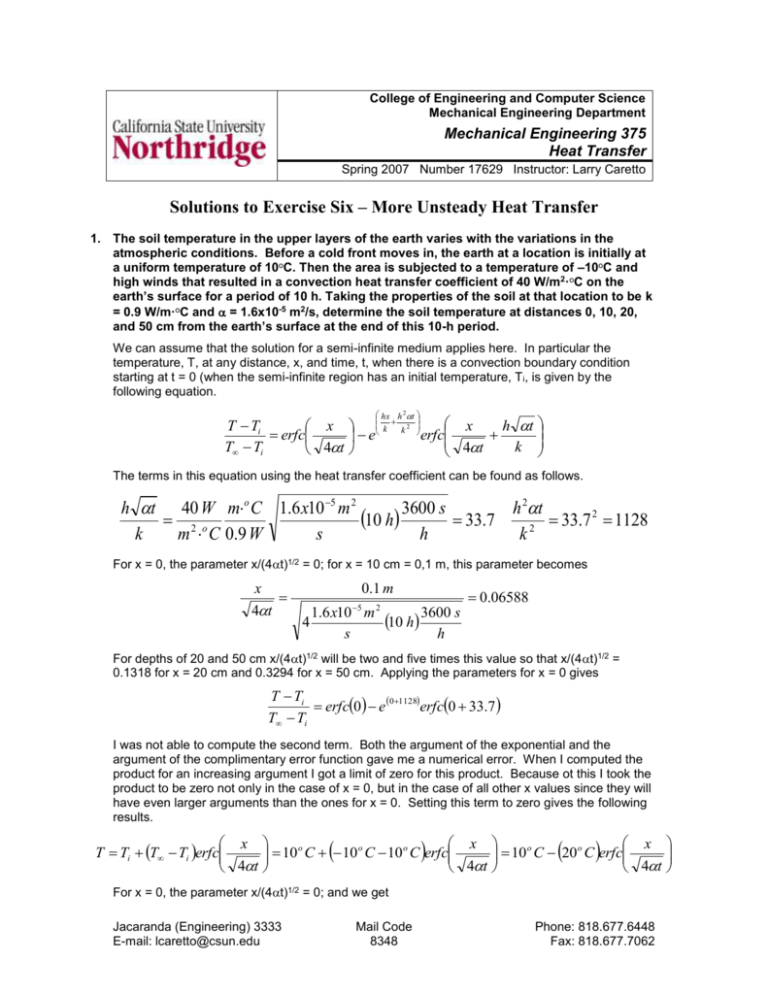
College of Engineering and Computer Science Mechanical Engineering Department Mechanical Engineering 375 Heat Transfer Spring 2007 Number 17629 Instructor: Larry Caretto Solutions to Exercise Six – More Unsteady Heat Transfer 1. The soil temperature in the upper layers of the earth varies with the variations in the atmospheric conditions. Before a cold front moves in, the earth at a location is initially at a uniform temperature of 10oC. Then the area is subjected to a temperature of –10oC and high winds that resulted in a convection heat transfer coefficient of 40 W/m2·oC on the earth’s surface for a period of 10 h. Taking the properties of the soil at that location to be k = 0.9 W/m·oC and = 1.6x10-5 m2/s, determine the soil temperature at distances 0, 10, 20, and 50 cm from the earth’s surface at the end of this 10-h period. We can assume that the solution for a semi-infinite medium applies here. In particular the temperature, T, at any distance, x, and time, t, when there is a convection boundary condition starting at t = 0 (when the semi-infinite region has an initial temperature, T i, is given by the following equation. hx h 2t k 2 T Ti x k erfc e T Ti 4t x h t erfc k 4 t The terms in this equation using the heat transfer coefficient can be found as follows. h t 40 W mo C 1.6 x10 5 m 2 3600 s h 2t 10 h 2o 33.7 33.7 2 1128 2 k s h m C 0.9 W k For x = 0, the parameter x/(4t)1/2 = 0; for x = 10 cm = 0,1 m, this parameter becomes x 4t 0.1 m 5 1.6 x10 m 2 10 h 3600 s 4 s h 0.06588 For depths of 20 and 50 cm x/(4t)1/2 will be two and five times this value so that x/(4t)1/2 = 0.1318 for x = 20 cm and 0.3294 for x = 50 cm. Applying the parameters for x = 0 gives T Ti erfc0 e 01128erfc0 33.7 T Ti I was not able to compute the second term. Both the argument of the exponential and the argument of the complimentary error function gave me a numerical error. When I computed the product for an increasing argument I got a limit of zero for this product. Because ot this I took the product to be zero not only in the case of x = 0, but in the case of all other x values since they will have even larger arguments than the ones for x = 0. Setting this term to zero gives the following results. x T Ti T Ti erfc 4t x o o o 10 C 10 C 10 C erfc 4t x o o 10 C 20 C erfc 4t For x = 0, the parameter x/(4t)1/2 = 0; and we get Jacaranda (Engineering) 3333 E-mail: lcaretto@csun.edu Mail Code 8348 Phone: 818.677.6448 Fax: 818.677.7062 Exercise five solutions ME 375, L. S. Caretto, Spring 2007 x T 10 o C 20 o C erfc 4t Page 2 10 o C 20 o C erfc0 10 o C 20 o C 1 –10oC . For x = 10 cm, the parameter x/(4t)1/2 = 0.06588; and we get x T 10 o C 20 o C erfc 4t 10 o C 20 o C erfc0.06588 10 o C 20 o C 0.9257 –8.5oC . For x = 20 cm, the parameter x/(4t)1/2 = 0.1318; and we get x T 10 o C 20 o C erfc 4t 10 o C 20 o C erfc0.1318 10 o C 20 o C 0.8519 –7.0oC . For x = 50 cm, the parameter x/(4t)1/2 = 0.3294; and we get x T 10 o C 20 o C erfc 4t 10 o C 20 o C erfc0.3294 10 o C 20 o C 0.6418 –2.8oC . 2. A short brass cylinder ( = 8530 kg/m3, cp = 0.389 kJ/kg·oC, k _ 110 W/m·oC, and = 3.39x10-5 m2/s) of diameter D = 8 cm and height H = 15 cm is initially at a uniform temperature of Ti = 150oC. The cylinder is now placed in atmospheric air at 20oC, where heat transfer takes place by convection with a heat transfer coefficient of h = 40 W/m2·oC. Calculate (a) the center temperature of the cylinder; (b) the center temperature of the top surface of the cylinder; and (c) temperature of the top outer radius of the cylinder, and (d) the total heat transfer from the cylinder 15 min after the start of the cooling. The cylinder can be solved as the product of the solution for the infinite cylinder and that of the infinite slab. The temperature at any point in the cylinder will be the product of two solutions. If the Fourier number is greater than 0.2 we can use the approximate solutions shown below. x, r , t 2 2 x r T T slab r , t cyl r , t A1e1 cos 1 i A1e1 J 0 1 Ti T Li s r0 c The subscripts s for slab and c for cylinder indicate that the values of A1 and 1 will be different for the different solutions. In addition, the Fourier numbers will be different for the slab (with a half width, L = (15 cm)/2 = 7.5 cm = 0.075 m, and the cylinder with a radius of (8 cm)/2 = 4 cm = 0.04 m. Using the total time of 15 minutes = 900 s, the Fourier number for the cylinder is cyl t 3.39 x10 5 m 2 r02 s 900 s 19.069 0.2 0.04 m 2 The Fourier number for the slab is t 3.39 x10 5 m 2 L2 s 900 s 5.424 0.2 0.04 m 2 Since both Fourier numbers are greater than 0.2 the use of the approximate solution is justified. Next we compute the Biot numbers to determine the values of A1 and 1 for each solution. mo C hL 40 W 0.02727 Bi slab 2 o 0.075 m k mC 110 W Exercise five solutions ME 375, L. S. Caretto, Spring 2007 Bicyl Page 3 mo C hro 40 W 0.01455 2 o 0.04 m k mC 110 W For Bi = 0.4 Table 4-2 shows that that A1 = 1.0045 and 1 = 0.1620 for the slab and A1 = 1.0036 and 1 = 0.1667 for the cylinder. We can now compute the center temperature of the cylinder where x = r = 0. (Note that cos(0) = J0(0) = 1.) 2 2 r T T 12 x A1e cos 1 A1e 1 J 0 1 A1e 1 Ti T L s r0 c A e 12 s 1 Substituting numerical values for, A1 and 1 for each geometry gives. 2 T T A1e 1 Ti T A e 1.0045e 12 s 1 0.1620 2 5.424 c 1.00361e 0.1667 2 19.069 c 0.8710.587 0.511 We can then find the temperature at the center of the cylinder. T T Ti T 0.511 20o C 150o C 20o C 0.511 –86.4oC . To find the temperature at the top center of the cylinder, the radial solution will still have the value of 0.587, but the rectangular solution has to be evaluated at x = L (equivalent to = x/L = 1). This solution is 2 2 x slab L, t A1e 1 cos 1 i 1.0045e 0.1620 5.424 cos0.1620 0.860 Li s So the product at the top center of the cylinder =s (0.860)(0.587) = 0.505. With this we find the desired temperature as T T Ti T 0.505 20o C 150o C 20o C 0.505 –85.6oC . To compute the temperature at the top outer radius we can use the axial solution that we just obtained, but we not have to determine the radial solution at the point where r/r o = 1. This requires that we multiply the exponential solution for r = 0 by the Bessel function J o(1r/ro) = Jo(1) = Jo(0.1667) = 0.9931. This gives a radial solution at the outer radius of (0.9931)(0.587) = 0.583. Multiplying this by the solution slab = 0.860 for the rectangular problem found above gives a product solution = 0.501. Solving for the temperature gives T T Ti T 0.501 20o C 150o C 20o C 0.501 –85.2oC . Note that this problem has a low Biot number and the temperature throughout the solid is close to uniform. The heat transfer can be computed from the equations for Q/Q max for the one-dimensional solutions given in equations (4-33) and (4-34) on page 235 of the text. Q Qmax sin 1 1 0, wall 1 slab Q Qmax J 1 2 0,cyl 1 1 1 cylinder The product solution for a two-dimensional case is given by the following modified product solution in equation 94-53) on page 251. Here the 2D solution is written in terms of the first and second dimension. Exercise five solutions ME 375, L. S. Caretto, Spring 2007 Q Qmax Q 2 D Qmax Q first Qmax Q 1 sec ond Qmax Page 4 first We can compute the values for the cylinder and the slab as the first and second dimensions directly. We know 0,slab =0.871 for the slab and 0,cyl =0.587 for the cylinder from the solution for the center temperatures, so we can substitute these values as well as the appropriate values for 1 to determine the Q/Qmax ratio for each dimension. Q Qmax sin 1 sin 0.1620 1 0, wall 1 0.871 0.133 1 0.1620 slab Similarly, for the infinite cylinder solution we get Q Qmax J 0.1677 0.0835 1 20.587 1 1 20.587 0.415 0 . 1677 0 . 1677 cylinder Now we can compute the value of Q/Qmax for the short clinder. Q Qmax Q Q Q 1 2 D Qmax first Qmax sec ond Qmax 0.133 0.4151 0.133 0.493 first To compute Q, we have to first find Qmax. This is the heat transfer if the entire solid changes temperature from Ti to T∞. Qmax mc p T Ti D(2 L)c p T Ti 8350 kg 0.389 kJ .08 m.15 m 150o C 20o C 325 kJ 3 m kg o C We thus find Q = Qmax(Q/Qmax) = (325 kJ)(0.493) or Q = 160 kJ .


